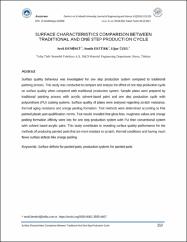SURFACE QUALITY COMPARISON BETWEEN TRADITIONAL AND ONE STEP PRODUCTION CYCLE
Abstract
Surfacequality behaviour was investigated for one step production system compared totraditional painting process. This study was conducted to compare and analysethe effect of one step production cycle on surface quality when compared withtraditional production system. Sample plates were prepared by traditionalpainting process with acrylic solvent based paint and one step production cyclewith polyurethane (PU) coating systems. Surface quality of plates were analysedregarding scratch resistance, thermal aging resistance and orange peelingformation. Test methods were determined according to Fiat painted plastic partqualification norms. Test results revealed that gloss loss, roughness valuesand orange peeling formation affinity were less for one step production systemwith PU than conventional system with solvent based acrylic paint. This studycontributes to revealing surface quality performance for the methods ofproducing painted parts that are more resistant to scratch, thermal conditionsand having much fewer surface defects like orange peeling. Surface quality behaviour was investigated for one step productionsystem compared to traditional painting process. This study was conducted tocompare and analyse the effect of one step production cycle on surface qualitywhen compared with traditional production system. Sample plates were preparedby traditional painting process with acrylic solvent based paint and one stepproduction cycle with polyurethane (PU) coating systems. Surface quality ofplates were analysed regarding scratch resistance, thermal aging resistance andorange peeling formation. Test methods were determined according to Fiatpainted plastic part qualification norms. Test results revealed that glossloss, roughness values and orange peeling formation affinity were less for onestep production system with PU than conventional system with solvent basedacrylic paint. This study contributes to revealing surface quality performancefor the methods of producing painted parts that are more resistant to scratch,thermal conditions and having much fewer surface defects like orange peeling.
Source
Kırklareli Üniversitesi Mühendislik ve Fen Bilimleri DergisiVolume
5Issue
2URI
https://doi.org/10.34186/klujes.626588https://dergipark.org.tr/tr/pub/klujes/issue/51429/626588
https://dergipark.org.tr/tr/download/article-file/913287
https://hdl.handle.net/20.500.11857/4250
Collections
- Makale Koleksiyonu [110]



















